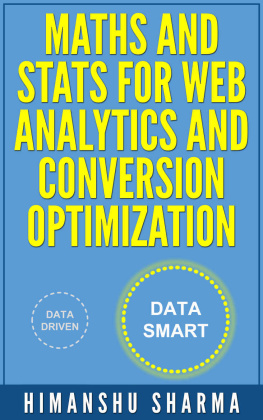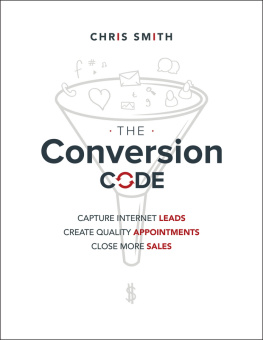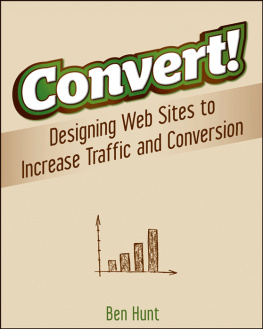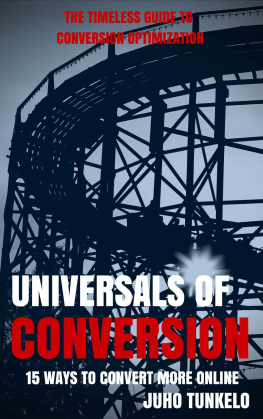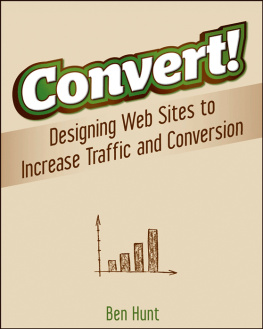Contents

Cover image: Paul McCarthy
Cover design: iStockphoto.com (Mouse: Materio/Money: DNY59)
Copyright 2013 by MorrisCore. All rights reserved.
Published by John Wiley & Sons, Inc., Hoboken, New Jersey.
Published simultaneously in Canada.
No part of this publication may be reproduced, stored in a retrieval system, or transmitted in any form or by any means, electronic, mechanical, photocopying, recording, scanning, or otherwise, except as permitted under Section 107 or 108 of the 1976 United States Copyright Act, without either the prior written permission of the Publisher, or authorization through payment of the appropriate per-copy fee to the Copyright Clearance Center, 222 Rosewood Drive, Danvers, MA 01923, (978) 750-8400, fax (978) 646-8600, or on the web at www.copyright.com . Requests to the Publisher for permission should be addressed to the Permissions Department, John Wiley & Sons, Inc., 111 River Street, Hoboken, NJ 07030, (201) 748-6011, fax (201) 748-6008, or online at www.wiley.com/go/permissions .
Limit of Liability/Disclaimer of Warranty: While the publisher and author have used their best efforts in preparing this book, they make no representations or warranties with the respect to the accuracy or completeness of the contents of this book and specifically disclaim any implied warranties of merchantability or fitness for a particular purpose. No warranty may be created or extended by sales representatives or written sales materials. The advice and strategies contained herein may not be suitable for your situation. You should consult with a professional where appropriate. Neither the publisher nor the author shall be liable for damages arising herefrom.
For general information about our other products and services, please contact our Customer Care Department within the United States at (800) 762-2974, outside the United States at (317) 572-3993 or fax (317) 572-4002.
Wiley publishes in a variety of print and electronic formats and by print-on-demand. Some material included with standard print versions of this book may not be included in e-books or in print-on-demand. If this book refers to media such as a CD or DVD that is not included in the version you purchased, you may download this material at http://booksupport.wiley.com . For more information about Wiley products, visit www.wiley.com .
ISBN: 978-1-118-75967-7 (cloth); ISBN 978-1-118-75974-5 (ebk); ISBN 978-1-118-75970-7 (ebk)
For Jenna ,
thanks for putting up with my many long hours during the writing of this book.
For my parents, Joe and Bebe ,
thank you for being early adopters and buying that first computer.
And Dad, thanks for making me try new things, even when I didnt want to.
Acknowledgments
Id like to thank Julie, Pat, Kevin, Adrianna, Brian, Lauren, Susan, Josh, and the rest of my team members for helping with this book.
Preface
Think about all the clicks on your web pages, on your e-mail, on your banner ads, on your social media posts, on all your online marketing. Now imagine each one of those clicks converted into cash in your pocket. Sounds pretty cool, doesnt it? It might also sound like an impossible dream, or some hyped-up sales pitch. But its not; converting every click is what companies that do business online can strive for. Can you truly convert every single click into cash? Lets think about it for a moment. If we give each person who comes in contact with your company exactly what they want, exactly how they want it, exactly when they want itthen, theoretically, they should buy. In other words, if we give each person an individualized experience thats customized to their wants, needs, and preferences, then theoretically they should always choose to buy from you. This might sound like a practical impossibility; but in theory, the idea is sound. When you combine the data gathering and testing technology that currently exists with a strong knowledge of psychology and human behavior, you can move closer and closer to customizing experiences for the individual. That brings you closer and closer to the goal of converting every click.
But is this really possible? Lets look at how far weve come in a relatively short time. First there was the Internet. And it was good. Smart businesses put up websites, mostly ugly ones, but any website was good enough. These were the early days of Web 1.0 when the Internet was basically a collection of online brochures. Websites were almost exclusively company-centric or creator-centric. Everything on the site revolved around what that company or creator wanted to say. In fact, the term brochure website was coined to mean a company-centric informational site.
Over time, technology and peoples comfort with interacting online led to a desire for users to interact with their online experience a little. The dawn of Web 2.0 saw user-generated content, such as blog commenting, product reviews, and eventually more sophisticated social media websites. Although this era gave users the ability to contribute to the web experience, the site owners were primarily delivering information and one-size-fits-all content. In fact, most of the web still operates this way.
Right now, were entering a new age of the customer-centric web. I like to call it Web 3.0. Its an age of a learning web, where websites are customized for the individual user as much as possible. Every experience is unique to the user. The websites actually change based on who is looking at them.
Think about it for a moment, and youll see this is already happening. Google uses data it knows about you, such as where youre located, your preferences, what youre searching for, and other factors, to make a customized experience thats more relevant to you. Amazon does something similar by offering individual recommendations for you based on what youve searched for in the past, what youve bought in the past, and other related metrics. Every Facebook News Feed is completely unique, based on you, your friends, and your preferences.
It may sound scary to people when they learn how much data can be collected and how a website can be altered to appeal to them individually. It all sounds a bit Big Brother to many people. However, the world is heading this way whether we like it or not. If your company (or the company you work for) doesnt adapt to this new age centered on the individual user, you wont be on the cutting edge. And you risk falling behind competitors.
Until recently, leveraging the power of the customer-centric web was only truly accessible to huge corporations like Google, Amazon, and Facebook. But even these companies now allow advertisers to reach users using similar data to target people that their products or services are the most relevant to. Web 3.0 is here, and the technology gives businesses the power to use data to come closer to converting every click into a lead or a customer. For example, as a Facebook advertiser, you can target users down to an extremely granular level.
Businesses are finally figuring out they need a combination of things to be successful online. They need a professional-looking website. They need traffic, preferably from a wide variety of sources, and they need results that help them make money. These results are what we broadly call conversion. At the end of the day, businesses need to convert the traffic coming to their website into money.
The goals are no different in the off-line world of brick-and-mortar businesses. Whether you operate a bank, a bakery, a clothing boutique, or whateverthe goal is to turn casual browsers into customers. You do that by making the shopping experience easy and enjoyable. You put signs in the right places, make up displays to attract the eye, suggest accessories and add-ons, and make sure the pathways direct people where you want them to go. However, even though youre optimizing the experience to make more sales, each person who walks in the door will get the same experience.


